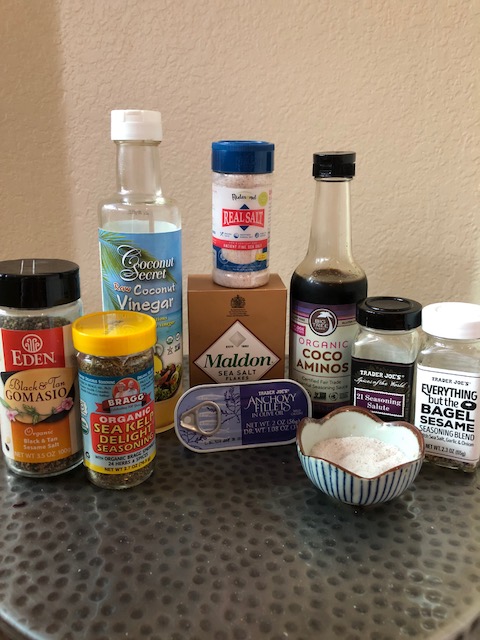To salt or not to salt…..that is the BIG question, isn’t it? For many of us, we have been led to believe that salt is bad and should definitely be avoided if you have high blood pressure or any kind of heart disease. But what if salt is not as bad as we thought? What if a low salt diet can be just as detrimental as a high salt diet? These were just a few of the topics covered in an interview I recently saw with Dr. James DiNicolantonio, author of the newly released book, The Salt Fix. Dr. DiNicolantonio is a cardiovascular research scientist and doctor of pharmacy at St. Luke’s Mid America Heart Institute in Kansas City, Missouri. With those credentials, I am guessing he probably knows a thing or two about heart health! His book takes a bold look at salt and argues that it should be a necessary part of our diet. And, I have to say, his ideas make sense to me. Let me explain.
Let’s start with the basics. Sodium and salt are used interchangeably, but chemically they are quite different. Salt is the common name for sodium chloride (NaHCL). Sodium is a naturally occurring mineral in our bodies and salt is naturally found in our seas and oceans. Besides adding flavor to our food, why do we need salt/sodium? For starters, sodium is the glue that holds water in our cells. Which is why if you have too much sodium, you will retain water. If you are consuming too little sodium, you will become dehydrated. Speaking of dehydration, did you know that you can lose 1/2 – 1 tsp. of sodium per hour of exercise? With the extreme heat and humidity we are experiencing, you could be sweating out quite a bit of sodium. Caffeine is also very dehydrating….you can lose up to a teaspoon of sodium from moderate caffeine consumption! So the reality is, most of us may already be at a deficit and adding in some salt may not put you over the top. When you are taking in the right kind of sodium (this is key) in the correct amounts, your body is able to regulate the sodium-potassium ratio and maintain the proper fluid balance.
Sea salt is rich in trace minerals and electrolytes. Our soil has become depleted of minerals, but trace minerals are still abundant in our seas and oceans and sea salt can contain between 60 and 80 trace minerals. Unrefined sea salt contains magnesium, calcium and potassium. These electrolytes have so many functions in the body one of which is to maintain our bone density. When sodium levels are too low, the body pulls sodium from our bones. It also pulls magnesium and calcium which puts us at risk for osteoporosis. As I mentioned, salt also contains chloride (HCL) which helps with digestion. A low salt diet can lead to low stomach acid resulting in poor digestion, inability to absorb nutrients and bacterial overgrowth. Lastly, sodium is essential for the transmission signals of our brain, muscles and nervous system. This is the communication system in our body and, if it is not functioning properly, so many things can get thrown off.
As you can see, on a molecular level, we need sodium for our bodies to function optimally. Although a diet high in sodium can be detrimental, a diet too low in sodium can have consequences as well. So, what is the sweet spot? The dietary guidelines by the American Heart Association recommend no more than 2300 mg. per day. However, if you look at countries like Korea and Japan, they consume 4000 to 5000 mg. of salt per day and the incidence of heart disease and high blood pressure is extremely low. How can that be?? Well, one of the main differences is the majority of their diet is based in natural whole foods which they cook themselves. Americans, on the other hand, have such a high rate of heart disease because of our standard American diet (SAD) which is filled with refined flours, partially hydrogenated oils and high amounts of refined table salt. Our SAD diet has created the perfect storm for skyrocketing obesity rates, hypertension and heart disease.
Now that we know we need sodium for our bodies to maintain equilibrium, the question remains what is the best source. I will give you a hint….it is not in processed foods ;). Personally, I have never been heavy handed with the salt shaker. Instead, I like to add foods that have a salty flavor. Some of my favorites are olives, celery, cucumbers, tomatoes, bell peppers, dark leafy greens, onions, carrots, lemons and, my all time favorite, anchovies. Now, before you turn your nose up at the idea of using anchovies, let me tell you my secret. Small anchovy fillets actually melt like butter in a hot skillet….it is so cool! I simply put a fillet into my heated pan, let it melt and then add my veggies, etc. There is no fishy taste at all, I swear. One fillet has about 100 mg. of sodium and really adds a nice subtle salty flavor.
As far as condiments, I like to use coconut vinegar and coconut aminos. The vinegar has zero salt and the aminos are coconut blossom nectar with Balinese sea salt. Coconut aminos are similar to tamari but aminos have a lot less sodium. I also use different spice blends which you can see in the photo below. All of these are between 30 and 80 mg. per 1/4 tsp. I recently discovered the Gomasio which is a combination of black and tan sesame seeds with sea salt. A teaspoon of Gomasio has 80 mg. of sodium.
If you are going to use salt, it is important to consider the source. Obviously, Morton’s salt should not be your first choice….ever! This salt is heavily processed and void of any nutrition. As I mentioned, sea salt contains trace minerals so I would encourage you to find unrefined sea salt. There is growing concern about the pollution in our oceans so the source of your sea salt is important. I use celtic sea salt which contains all of the trace minerals found in the body. It is harvested from the Celtic sea near Brittany, France using a 2,000 year old method which retains all of the vital nutrients. I also like Redmond Real Salt which is harvested in an ancient ocean near Redmond, Utah.
So, there you have it! I hope I was able to enlighten you a bit about some of the benefits of salt/sodium. It is important to remember that we all have unique dietary needs. You know your body better than anyone so use this information wisely if you decide to make any changes to your salt intake. Remember to consult your health care practitioner if you have any heart related issues. Be sure to show them this article….perhaps you will enlighten them as well!
As always, if you have any questions, hit reply and let’s chat. Until next time, have fun experimenting with the different foods and condiments that I mentioned. And, please try the anchovies……you will thank me!!



